A Holistic Approach to Restoring Streams
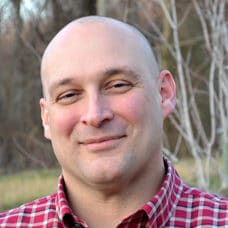
“It’s difficult to get long contiguous stretches of a watershed, particularly headwaters, restored,” says Matt Ehrhart, director of watershed restoration at Stroud Water Research Center.
It’s certainly ideal but also rare for all landowners along a stretch of stream to implement best management practices (BMPs) for water quality. At best, there may be a few scattered here and there.
However, the Stroud Center’s Watershed Restoration Group is building relationships with all of the farmers along two headwater tributaries to restore, protect, and monitor them.
One is an unnamed tributary to Mill Creek in central Lancaster. The other, also unnamed, flows into Little Conestoga Creek in Eastern Pennsylvania. Both eventually lead to the Susquehanna River and Chesapeake Bay. They’re also impaired and targets of the Clean Water Act.
A GROWING PARTNERSHIP
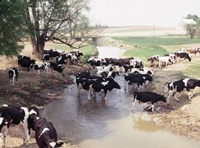
Some of the farmers participating in the project have already taken steps to reduce runoff and move cows away from the streams. By partnering with the Lancaster County Conservation District, the Natural Resources Conservation Service, Red Barn Consulting, Inc., and TeamAg, Inc., the Watershed Restoration Group will help farmers do even more.
“Our goal is to add forested riparian buffers along the entire length of these two stream stretches over the next two years. Buffers are highly effective, so they will play a key role,” Ehrhart says. “But buffers can become overwhelmed when used in isolation, so also important will be barnyard improvements for manure management, rain gutters and spouting, no-till farming, and grassed waterways.”
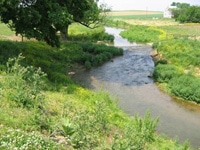
Improvements such as buffers are low-cost alternatives that take time to mature and reach their full potential. Associate Research Scientist John Jackson, Ph.D., says, “From our perspective, it’s better to address 10,000 feet of stream or 1,000 acres of farmland by using these low-cost BMPs than to address a much smaller area using more expensive solutions that maybe look good right away — because even if you do everything right in one location, if the farms upstream are polluting the water, it’s going to affect everyone downstream.”
TWO TRIBUTARIES, ONE LONG STUDY
The case for widely used low-cost BMPs would benefit from science that proves their value. The problem is that long-term data describing their effectiveness and how long it takes to restore an impacted stream are lacking.
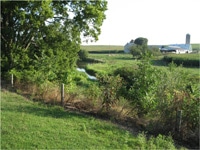
Jackson and his team of researchers will fill the gap by studying the health of the two tributaries over many years, possibly decades. Right now, they’re in the process of establishing a baseline.
Stroud Center scientists like Jackson evaluate and help improve the condition of streams not by measuring one indicator or employing one cure-all method, but by using many tools all together. “It’s like the difference between only taking care of your heart versus your whole body.” Jackson explains. “Will your body be better off if you take care of your heart? Sure. But if you do that in isolation and neglect your lungs then your body may still suffer. The same is true for monitoring and restoring stream health.”
This project is unique in that it presents a best-case scenario. What happens when everything is done right to restore a stream?
“Different parties have different ways of measuring success,” adds Ehrhart, “For example, the biggest concern in terms of cleaning up the Chesapeake Bay is reducing nitrogen loads and then phosphorus and sediment. There are things that can be done on the landscape to reduce the amount of nitrogen flowing into a stream right away, but it can take decades to flush out sediment.”
“Everybody wants to know how long it takes to clean up an impacted stream. No one really knows. We’re changing that,” says Jackson.
Ehrhart agrees. “Yes, and we think the data will serve as an incentive for more landowners to implement BMPs.”
Staff Spotlight: Sally Peirson and Roberta Weber
By Diane Huskinson
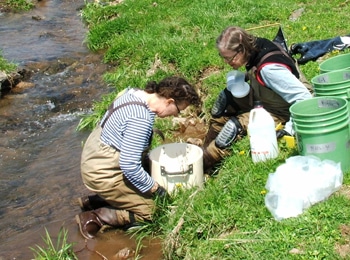
Sally Peirson and Roberta Weber, both Stroud Water Research Center staff scientists, have worked side by side in the Entomology Group for nearly 30 years. They’ve shared not just a workspace but many of life’s big events like marriages, graduations, children, and grandchildren. And this duo is glad about that.
“We’re more than co-workers; we’re good friends,” says Peirson. “After working together for so long, Roberta even finishes my sentences.”
Weber adds, “Around here, people refer to us like we’re one person. Sally is great, so if I am going to be someone’s Siamese twin, I’m glad it’s hers.” She looks at her friend, and they share a laugh.
Though both are shy about singing their own praises, each one is quick to acknowledge the other’s qualities.
“Sally is a meticulous, careful, patient person, and she sets a great example to the young people who are just starting out in the lab,” Weber says, to which Peirson replies, “Well, I’d say the same about her.”
Equally conscientious and having decades of experience, they are the indispensable boots on the ground responsible for helping senior scientists carry out research projects. When out in the field, they collect stream samples, and in the lab, they process those samples, identify collected macroinvertebrates, and log data.
Roberta Weber started in April 1983. A New Castle, Del., native, she attended DeLaWarr High School, where her science teacher, Mr. O’Neill, inspired her to study biology in college. Afterward, she spent two years in the Philippines as a Peace Corp volunteer working in rural public health. Upon her return to the U.S., she tried out several odd jobs before settling into the University of Delaware’s entomology graduate program. “When I heard about an opening at Stroud, I applied, and here I am.” Roberta shares a passion for entomology with her husband Richard Weber, a retired entomology professor.
Sally Peirson is the daughter of the late Jean and Buck Peirson. She grew up across the street from the Center and became a part-time employee in high school. After graduating in June 1972, she was hired into the Entomology Group. “I feel like I fell into my job, but I’m glad I did. I love the people here.” She celebrates her 41-year anniversary at the Center this year. Peirson and husband John Baker, an artist and West Chester University professor, have two daughters and four grandchildren.
Teacher Testimonial: Why Terri James Brings Students to Stroud
“Stroud Water Research Center is an incredible resource for our community, not only because of the important research it is doing but also because of its educational outreach.
I have had the privilege of taking my students to the Center for more than two decades. Here they have been introduced to macroinvertebrates and the importance of these organisms as indicators of stream health.
The enthusiasm fostered by the education staff, the hands-on nature of the investigation, and the diversity provided by a first-class stream have become a vital and integral part of our study of trees and their importance to the health of streams. The White Clay Creek has been a baseline for comparing investigations of streams on and near our campus.
This beginning experience provides a foundation and connection to other parts of our curriculum from understanding the wider implications to our watershed to experiences on our canoe trips on the Mullica River in Delaware and the West Branch of the Susquehanna River.
And it’s just plain fun!”
— Terri James, Teacher, Westtown School
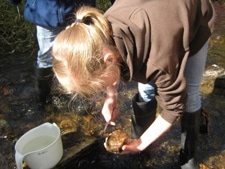
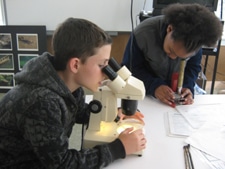
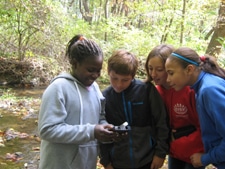
Events
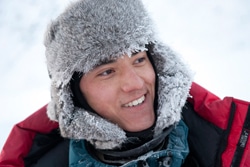
Joan and Dick Stroud Memorial Lecture
Featuring the Documentary Film Chasing Ice and Special Guest Speaker, Director/Producer Jeff Orlowski
Sun., September 15, 4 p.m.–7 p.m.
Copeland Lecture Hall
Winterthur Museum
5105 Kennett Pike, Wilmington, Del.
$15 per person; includes light refreshments.
Chasing Ice is the story of one man’s mission to change the tide of history by gathering undeniable evidence of climate change. Using time-lapse cameras, his videos compress years into seconds and capture ancient mountains of ice in motion as they disappear at a breathtaking rate.
“If there was ever a film that needed to be on the big screen, this is it!” — David Courier, Sundance senior programmer
“Amazingly beautiful… FIVE STARS” — The New York Daily News
“Stunning … timely … a solitary quest with global implications.” — The New York Times, ‘Critic’s Pick’
About the Speaker
In 2007, Jeff Orlowski got his first taste of the Arctic when as a Stanford student he seized an opportunity to work as a videographer with National Geographic photographer James Balog on the initial expedition of The Extreme Ice Survey (EIS). That winter, the EIS team scouted and filmed glaciers that now appear in the documentary feature film Chasing Ice.
Orlowski, a New York native, has been filming the EIS project around the world, working in some of the most extreme conditions imaginable on locations in Iceland, Greenland, Bolivia, the Alps, Alaska, and Glacier National Park, Montana.
Jeff’s previous work has taken him to the Tour de France for a behind-the-scenes documentary, and he has photographed and filmed a number of people including Robin Williams, Jane Goodall, and Nelson Mandela.
Mr. Orlowski will introduce the film and answer questions after the film is screened.
In the News
LEED® Platinum Certification Highlight of Center’s Earth Day Celebration
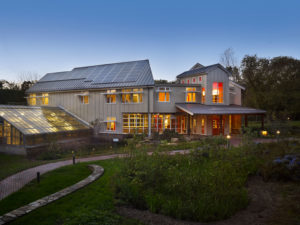
On Earth Day, Stroud Water Research Center announced that its Moorhead Environmental Complex had achieved the highest honor in green building design: LEED® Platinum. Read the press release or check out the story in The Unionville Times.
Planting Trees for Great Beer
This spring, Bill Covaleski of Victory Brewing Company and about 35 volunteers planted 1,200 trees along the East Branch of the Brandywine Creek. Good clean water is a must for great beer, and trees planted along streambanks help filter pollutants from entering streams. Stroud Water Research Center often helps groups — including this one — administer tree-planting projects through the TreeVitalize program. Read the story and learn more about the benefits of trees.
New University Research Center
A new university research and education center is in the works to provide college students from James Madison University and elsewhere a facility in which to study the science, technology, engineering, and mathematics (STEM) disciplines. The Center for Coldwaters Restoration project will take $30 million and 20 years to complete.
Research and education centers offering the chance to study freshwater streams and rivers are few and often far between. Stroud Water Research Center, which serves students in middle school through graduate school and provides opportunities like field trips and post-doctoral research positions, is in an even smaller minority, as it is also nongovernmental, nonadvocacy, nonprofit, and independent from any university.
Stroud Scientists and Educators Present
Our scientists and educators engage in both scientific and public forums to share their findings, increase awareness, and create a public dialogue centered on the protection, preservation, and restoration of watersheds everywhere. The following highlights recent presentations.
Scientists, Educators Share Knowledge at Society for Freshwater Science Meeting
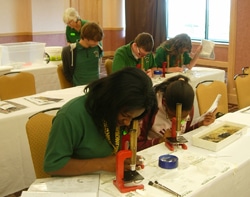
Stroud Center Director Bern Sweeney, Assistant Director Dave Arscott, scientists Dave Funk and John Jackson, and educator Christina Medved attended the annual meeting of the Society for Freshwater Science (formerly the North American Benthological Society) held this year in Jacksonville, Fla., May 19-23.
Medved organized a Leaf Pack Experiment Workshop for Greenwood School students, Jacksonville Zoo staff, teachers from other area schools, and staff from the Florida Department of Environmental Protection South Florida Water Management District. The Center also set up an exhibit to share information about the Center and its programs with conference attendees.
Scientific presentations were delivered by Arscott, Funk, Jackson, and Sweeney:
- Gill, S. E., Aufdenkampe, A. K., & Arscott, D. Model My Watershed®: Developing Online Hydrologic Modeling Capacity for Students and Citizens. Presentation delivered on behalf of Director of Education Susan Gill.
- Richardson, D. C., Oleksy, I. A., Hoellein, T. J., Arscott, D. B., Gibson, C. A., & Root, S. M. Spatial Distribution and Ecosystem Effects of a Nuisance, Bloom-Forming Diatom (Didymosphenia geminata) in Catskill Mountain Streams, New York.
- Funk, D. H., & Jackson, J. K. The Toxicity of Produced Water from Marcellus Shale Gas Wells to Three Natives Mayflies.
- Conley, J. M., Funk, D. H., & Buchwalter, D. B. Toxicity of Elevated Total Dissolved Solids and Dietary Selenium to Aquatic Insects Using Centroptilum triangulifer as a Model Organism.
- Jackson, J. K. Revisiting the Role of Long-Term Studies in Freshwater Ecology.
- Sweeney, B. W., Flowers, R. W., Funk, D. H., Huamantinco, A. A., Jackson, J. K., & Ojeda, T. Using Leaf Packs to Monitor Water Quality Along an Altitudinal Gradient Near the Transoceanic Highway in the Eastern Andes Region of Peru.
- Buchwalter, D. B., & Sweeney, B. W. Thermal Tolerance in Aquatic Insects: A Psychological Perspective.
Advancing Data Management and Cyberinfrastructure

The Organic and Isotope Geochemistry Group had a busy spring with Associate Research Scientist Anthony Aufdenkampe attending and presenting at two workshops. In March, he attended the two-day Workshop #1 for the Observations Data Model 2.0 (ODM2) Project in San Diego, for which he served on the organizing committee and presented several times. ODM2 is an information model that builds upon data management technologies, making it possible for scientists more easily share their observations of Earth. Sara Damiano also attended.
In April, Aufdenkampe participated in an EarthCube Domain End-User Workshop: Integrating the Inland Waters Geochemistry, Biogeochemistry, and Fluvial Sedimentology Communities, the goal of which was to identify cyberinfrastructure and data management needs of the earth sciences community and to guide the development of the U.S. National Science Foundation (NSF) EarthCube cyberinfrastructure initiative. Aufdenkampe was on the organizing committee for this workshop, and he gave two pop-up presentations and a poster presentation.



